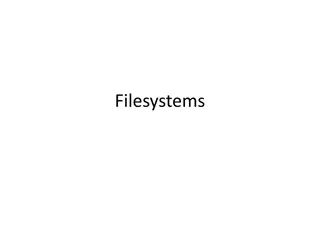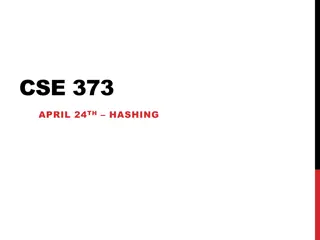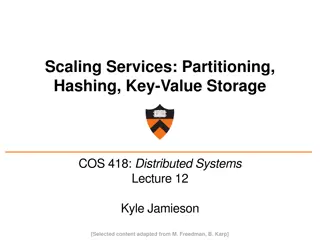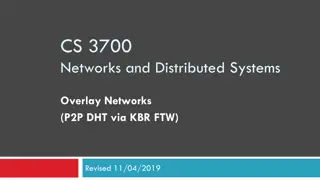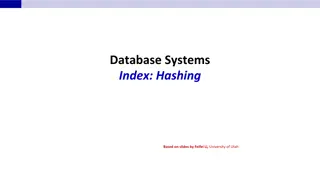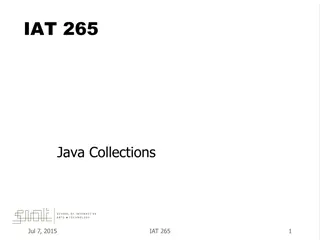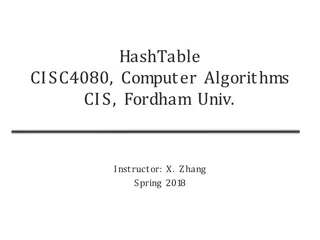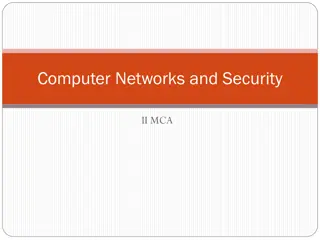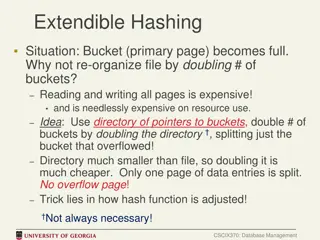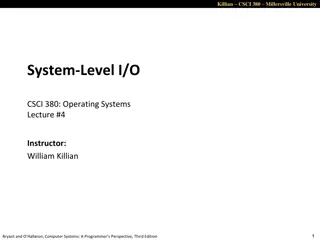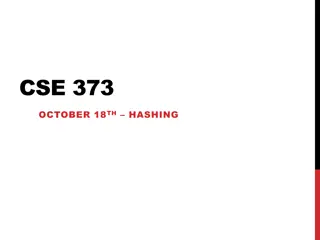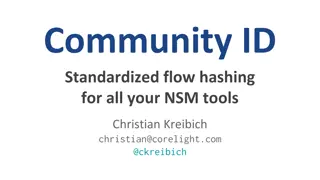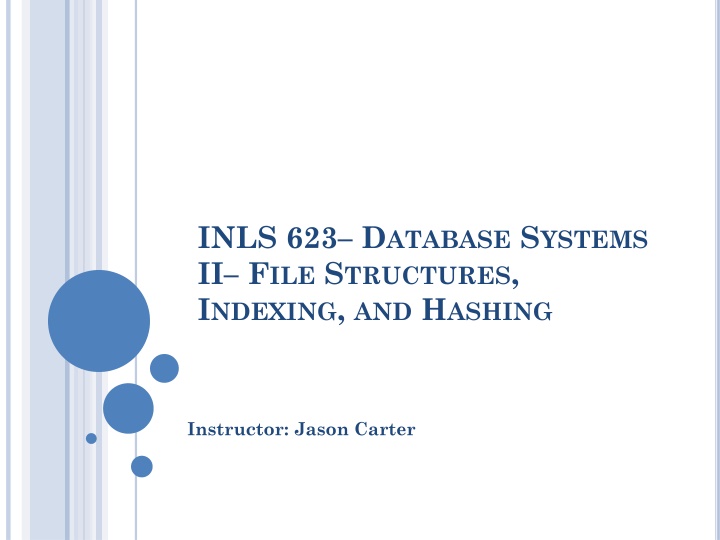
Database Systems II: File Structures, Indexing, and Hashing Review
Explore the concepts of file storage, memory management, disk storage devices, records, and blocking in the context of database systems. Understand how tables are physically stored, memory hierarchy, file storage choices, disk organization, record structures, and blocking factors impact database operations.
Download Presentation

Please find below an Image/Link to download the presentation.
The content on the website is provided AS IS for your information and personal use only. It may not be sold, licensed, or shared on other websites without obtaining consent from the author. If you encounter any issues during the download, it is possible that the publisher has removed the file from their server.
You are allowed to download the files provided on this website for personal or commercial use, subject to the condition that they are used lawfully. All files are the property of their respective owners.
The content on the website is provided AS IS for your information and personal use only. It may not be sold, licensed, or shared on other websites without obtaining consent from the author.
E N D
Presentation Transcript
INLS 623 DATABASE SYSTEMS II FILE STRUCTURES, INDEXING, AND HASHING Instructor: Jason Carter
REVIEW Databases Logically Coherent Collection of related data Database has tables and there are relationships between the tables Where are those tables physically stored?
MEMORY Primary Memory Random Access Memory (RAM) Secondary Memory Disk (Hard Disk) Tape Solid State Devices (SSD) DVD/Blue Ray How are those table stored in memory?
FILE STORAGE Which type of memory do we typically store files in and why? Secondary Storage Secondary Storage is persistent and cheaper (than primary storage) Primary memory is faster We chose persistence and money over speed
DISK STORAGE DEVICES (CONTD.) A track is divided into smaller blocks or sectors because it usually contains a large amount of information The division of a track into sectors is hard-coded on the disk surface and cannot be changed. One type of sector organization calls a portion of a track that subtends a fixed angle at the center as a sector. A track is divided into blocks. The block size B is fixed for each system. Typical block sizes range from B=512 bytes to B=4096 bytes. Whole blocks are transferred between disk and main memory for processing.
RECORDS Records = Rows in a table Fixed and variable length records Records contain fields (attributes) which have values of a particular type E.g., amount, date, time, age Fields themselves may be fixed length or variable length Variable length fields can be mixed into one record: Separator characters or length fields are needed so that the record can be parsed.
BLOCKING Blocking: Refers to storing a number of records in one block on the disk. Blocking factor (bfr) refers to the number of records per block. remember block size is a constant for a device Spanned Records: Refers to records that exceed the size of one or more blocks and hence span a number of blocks.
FILESOF RECORDS A file is a sequence of records, where each record is a collection of data values (or data items). Think of a file as a table though one can have multiple tables in a file A file descriptor (or file header) includes information that describes the file, such as the field names and their data types, and the addresses of the file blocks on disk. Records are stored on disk blocks. The blocking factorbfr for a file is the (average) number of file records stored in a disk block. A file can have fixed-length records or variable-length records.
FILESOF RECORDS (CONTD.) File records can be unspanned or spanned Unspanned: no record can span two blocks Spanned: a record can be stored in more than one block The physical disk blocks that are allocated to hold the records of a file can be contiguous, linked, or indexed. In a file of fixed-length records, all records have the same format. Usually, unspanned blocking is used with such files. Files of variable-length records require additional information to be stored in each record, such as separator characters and field types. Usually spanned blocking is used with such files.
Unordered Files Also called a heap or a pile file. New records are inserted at the end of the file. Deletion can be to mark a record as invalid Later compaction can be done to recover space. A linear search through the file records is necessary to search for a record since the files are unordered This requires reading and searching half the file blocks on the average, and is hence quite expensive. Record insertion is quite efficient. Reading the records in order of a particular field requires sorting the file records after reading.
Ordered Files Also called a sequential file. File records are kept sorted by the values of an orderingfield (eg. SSN) Insertion is expensive: records must be inserted in the correct order. It is common to keep a separate unordered overflow (or transaction) file for new records to improve insertion efficiency; this is periodically merged with the main ordered file. A binary search can be used to search for a record on its ordering field value. This requires reading and searching log2 of the file blocks on the average, an improvement over linear search. Reading the records in order of the ordering field is quite efficient.
ITEMS TABLE Field item_id title long_text item_date deleted category Data Type int varchar text datetime Enum( Y , N ) int
FINDING DATA SELECT * FROM items WHERE category=4; How does MYSQL know where to find and return the data for this query? 1.Start at the beginning of the file 2.Read in enough to know where the category data field starts 3.Read in the category value 4.Determine if it satisfies the where condition 5.If it does add that record to the return set 6.If it doesn t figure out where the next record set is and repeat
FINDING DATA (CONTINUED) Database will read the entire data file off disk It does not matter how many rows satisfy the where clause This is very inefficient! Using a SQL command, how can we make this process more efficient?
MAKING DATA FINDINGMORE EFFICIENT Use the LIMIT Keyword SELECT * FROM items WHERE category=4 LIMIT 1; When does this query stop reading from disk? After the correct row is found. If row is at end of table, we still waste time reading the disk. Can we make reading data more efficient?
INDEX: MAKING DATA FINDINGMORE EFFICIENT An index is a data structure that makes finding data faster Adds additional storage space and writes to disk to maintain the index data structure Holds a field value, and pointer to the record it relates to Indexes are sorted What is a data structure? A way of organizing data in a computer so that it can be used efficiently
DATA STRUCTURES Array Hashtable/DictionaryAssociative Array Tuple Graphs Trees Object
ARRAY: DATA STRUCTURES A collection of elements (values or variables), each identified by at least one array index or key
WHATARE INDEXES? An index on a file speeds up selections on the search key fields for the index Any subset of fields from a table can be a search key. Search key is not necessarily the same as the table s key (minimal set of fields that uniquely identify a record in a relation). An index contains a collection of data entries, and supports efficient retrieval of all data entries k* with a given key value k. Given data entry k*, we can find record with key k in at most one disk I/O.
INDEXING Have we ever used indexes before? When we set primary keys
ARRAYSFOR INDEXING Holds a field value, and pointer to the record it relates to Indexes are sorted Can an array be used for indexing?
TWO TYPESOF INDEXES Clustered Index Unclustered/Non-clustered Index
CLUSTERED INDEX Determines the order in which rows of a table are stored on disk The rows of a table is stored on disk in the same exact order as the clustered index Only one index per table Default index in MySQL when you create a primary key
CLUSTERED EXAMPLE Owners Owner_ID (PK) name age Cars Car_ID(PK) Owner_ID ((PK) type
CLUSTERED EXAMPLE Owners OwnerID | name | age 1 2 J K 42 35 Cars CarID | OwnerID | type 1 2 1 1 Ford Mustang We run a query that frequently gets an owner and his cars. What column(s) in the Cars table should be clustered?
CLUSTERED INDEX EXAMPLE Create a clustered index on the (carID, ownerID)column in the Cars table A given ownerID would have all his/her car entries stored right next to each other on disk If the query to frequently get an owner and all his/her car this runs extremely fast Is there a disadvantage to using clustered indexes? If we update one of the values of a clustered index, the database has to resort the rows - This involves deleting and inserting, which is a performance hit! Typically, clustered indexes are on PK and FK cause those values aren t updated much
UNCLUSTERED/NONCLUSTERED INDEX The index is stored separately from the table data Store the value of the column indexed and a pointer to the row the data is stored Can have multiple unclustered indexes Called secondary indexes in MySQL Unclustered indexes are faster when updating
HASH-BASED INDEXING Place all records with a common attribute together. Index is a collection of buckets. Bucket = primary page plus zero or more overflow pages Buckets contain data entries. Hashing function h(r): Mapping from the index s search key to a bucket in which the (data entry for) record r belongs.
B TREES FORINDEXING A tree data structure that keeps data sorted and allows searches, sequential access, insertions, and deletions in logarithmic time O(log N) basically means time goes up linearly while the n goes up exponentially. So if it takes 1 second to compute 10 elements, it will take 2 seconds to compute 100 elements, 3 seconds to compute 1000 elements, and so on.
B TREEAND INDEXING EXAMPLE Index for item_id 4 sorted values representing the range of item_ids The child nodes have the same range values last level nodes containing the final item_id value and pointer to the byte in the disk file the record lies
B TREEAND INDEXING EXAMPLE Looking for item_id 4 Is this really more efficient?
B TREEAND INDEXING EXAMPLE We needed to do 3 hops to get to item id 4. We had to look at the entire index for item_id Looking for item_id 20
B TREEAND INDEXING EXAMPLE We needed to do 3 hops to get to item id 20. # of hops required increases in a sort-of logarithmic manner with respect to database size Opposite to exponential growth Logarithmic shoots up in the beginning, but slows Exponential grows slowly at the beginning, but shoots up rapidly
INDEXING: GENERAL RULESOF THUMB Index fields in the WHERE CLAUSE of a SELECT Query User Table ID (INT) PK Email_address During login, MySQL must locate the correct ID by searching for an email Without an index, every record in sequence is checked until the email address is found
INDEXING: GENERAL RULESOF THUMB Should we add an index to every field? No, because indexes are regenerated during every table INSERT OR UPDATE Hurts performance
INDEXING: GENERAL RULESOF THUMB Only add indexes when necessary Indexes should not be used on small tables. Tables that have frequent, large batch update or insert operations. Indexes should not be used on columns that contain a high number of NULL values. Columns that are frequently manipulated should not be indexed.



